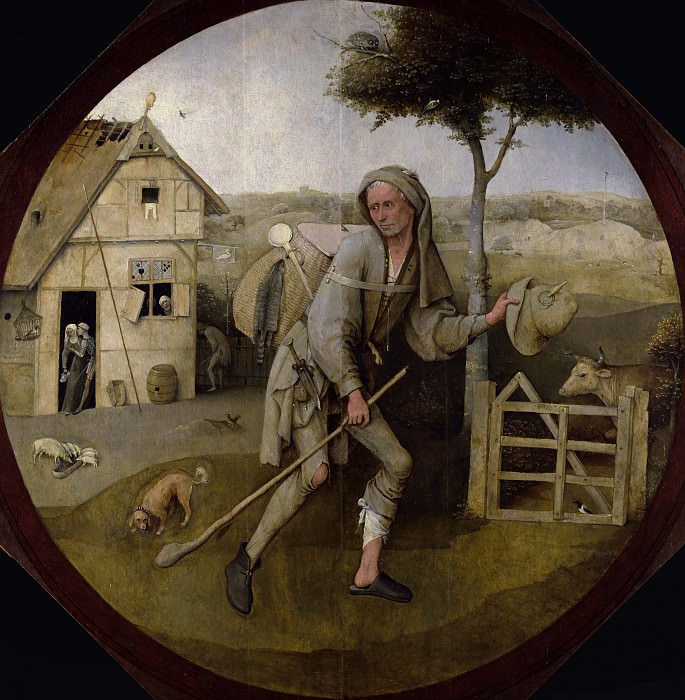The Wayfarer Hieronymus Bosch (1450-1516)
Hieronymus Bosch – The Wayfarer
Edit attribution
Download full size: 6900×7058 px (10,6 Mb)
Painter: Hieronymus Bosch
Location: Museum Boijmans Van Beuningen, Rotterdam.
Painter Hieronymus Bosch always left riddles and places for the viewer to ponder in the subjects of his paintings. With his brush, he not only masterfully painted beautiful images, but he also put deep allegories into them that not every art lover could understand. The scene of the return of the prodigal son he also saw and delivered to the viewer in his complex and enigmatic manner of performance. The main character of this painting is the prodigal son.
Description of Hieronymus Bosch’s The Prodigal Son
Painter Hieronymus Bosch always left riddles and places for the viewer to ponder in the subjects of his paintings. With his brush, he not only masterfully painted beautiful images, but he also put deep allegories into them that not every art lover could understand.
The scene of the return of the prodigal son he also saw and delivered to the viewer in his complex and enigmatic manner of performance.
The main character of this painting is the prodigal son. He has decided to end his miserable misery and return to a decent and pure life. The man looks very thin and slouchy. This is a sign that the meager pennies he sometimes has are not always enough to buy food.
The wanderer’s clothes are in a very poor condition. They are shabby, stretched and torn in places. But it is unlikely that he has a change of underwear.
Before departing on his long journey to his birth father, the hero casts a parting glance at his place of abode. From now on, he will not cross the threshold of this filthy tavern. His departure attracts the attention of a woman. She looks out the window of the decaying building and may even be jealous of the hero.
He had the strength to escape from this unfortunate place. The rest of the inhabitants of the squalid asylum do not care about what is going on. They do not think about morality and do not seek to change their lives.
You can tell from the look on the traveler’s face that he is tired of dragging out his miserable existence and he despises the brothel, with all the souls living in it. But the hint of a smile and raised eyebrows suggests that the hardships of fate have not completely extinguished his spirit and desire for better things. He now understood much.
Hieronymus Bosch was a deeply religious man. He wanted to put into the meaning of his painting not only the description of the famous parable. The path from evil to good and from sin to God is always thorny. And only the one who has passed it to the end will receive the long-awaited happiness.
Кому понравилось
Пожалуйста, подождите
На эту операцию может потребоваться несколько секунд.
Информация появится в новом окне,
если открытие новых окон не запрещено в настройках вашего браузера.
You need to login
Для работы с коллекциями – пожалуйста, войдите в аккаунт (open in new window).
















COMMENTS: 1 Ответы
БРОДЯГА
Дыры на одежде будто раны.
Сколь бродяги ранена душа?
Сколь дороги человеку рады?
Их одолевает, не спеша…
Сетью мир тебе поймать бродягу
Не удастся – путь его горазд.
Хоть похож он телом на корягу,
Но души паренье Отче даст.
You cannot comment Why?
The painting depicts a solitary figure, a wayfarer, walking away from a dilapidated house and towards a somewhat desolate landscape. The wayfarer is clad in simple, worn clothing and carries a large basket on their back, supported by a staff. Their gaze is directed forward, their expression one of weariness or perhaps determination.
The house behind them shows signs of disrepair, with broken windows and a damaged roof. Inside the doorway, a couple embracing can be seen, hinting at domestic life left behind or perhaps a troubled relationship. Several animals – sheep and a dog – are clustered near the house, suggesting a connection to the rural setting.
In the foreground, the wayfarers bent posture and the worn soles of their shoes emphasize the arduous nature of their journey. A single stick serves as a walking aid, and a needle is prominently visible stuck in their clothing, a detail that has sparked various interpretations, often linked to good luck or protection.
The landscape beyond is sparsely populated, with rolling hills and a few trees under a muted sky. A cow stands near a rustic wooden gate, and a small bird perches on a branch above the wayfarer. The overall atmosphere is one of solitude and the challenges of travel in a world that appears somewhat bleak.
The subtexts of The Wayfarer are open to interpretation, but several themes are commonly discussed:
The ambiguity of the scene, with its blend of the mundane and the symbolic, allows for a rich tapestry of meanings, inviting viewers to contemplate their own journeys and the choices they make.